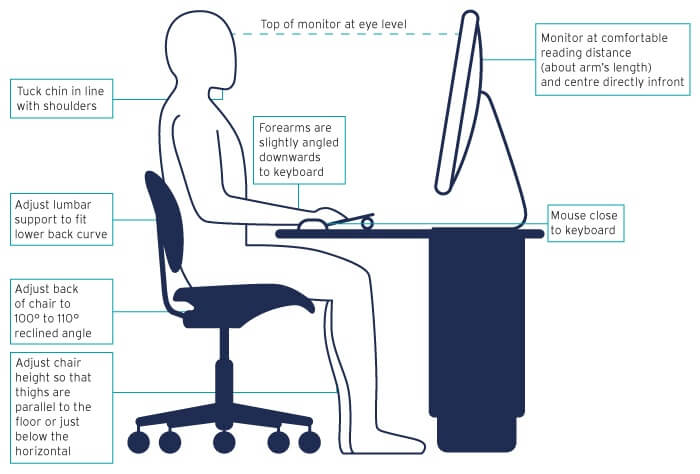1. Your Chair
This audio snippet will appear in a separate window.
Your chair is indeed arguably the most important piece of equipment in your workspace after your computer or laptop. Since most office workers spend 6-8 hours daily seated at their desk or workspace, your chair fundamentally impacts your comfort, health, productivity, and long-term well-being.
Why Chair Selection Matters
Your chair serves as the foundation for proper ergonomics. An improperly fitted chair can lead to:
Chronic lower back pain
Neck and shoulder tension
Reduced circulation in legs
Increased fatigue
Diminished focus and productivity
Long-term musculoskeletal disorders
Studies show that ergonomic seating can reduce workplace discomfort by up to 65% and increase productivity by 17.5% compared to standard office furniture.
Essential Chair Features
Adjustability
A proper office chair should offer multiple adjustment points:
Height adjustability: Feet should rest flat on the floor with knees at a 90° angle
Seat depth adjustment: Allow 2-4 fingers of space between the edge of the seat and back of knees
Backrest angle: Ability to recline slightly (100-110°) to reduce spinal pressure
Armrest height and width: Should support arms with shoulders relaxed
Lumbar Support
Crucial for maintaining the natural curve of your spine:
Look for adjustable lumbar support that can be positioned to fit your specific back curve
The lumbar support should fill the gap between your lower back and the chair
Some high-end chairs offer dynamic lumbar support that moves with you
Material and Construction
Breathable fabric: Prevents heat buildup during long sitting periods
Sufficient padding: Balances comfort with support
Sturdy base: A five-point base provides stability
Quality casters: Allow smooth movement appropriate to your flooring
Finding Your Perfect Fit
When selecting a chair:
Test before purchasing: Sit in potential chairs for at least 15 minutes
Consider your proportions: Chair dimensions should match your body size
Think about your work style: Different tasks may require different features
Check weight capacity: Ensure the chair is rated for your weight
Optimizing Your Existing Chair
If replacing your chair isn't an option:
Add aftermarket lumbar support cushions
Use seat cushions to adjust height
Consider ergonomic accessories like footrests to complement your chair setup
Maintenance and Replacement
Clean fabric components regularly
Tighten loose parts quarterly
Replace when support structures begin to fail (typically 7-10 years)
A quality ergonomic chair represents an investment in your health. While premium models can cost $500-1500, the prevention of health issues and productivity gains typically justify the expense over the chair's lifespan.
Remember that even the best chair cannot compensate for continuous sitting. Complement your chair with regular standing, stretching, and movement throughout the day for optimal workplace wellness.
Image Courtesy of: Elm Workspace
